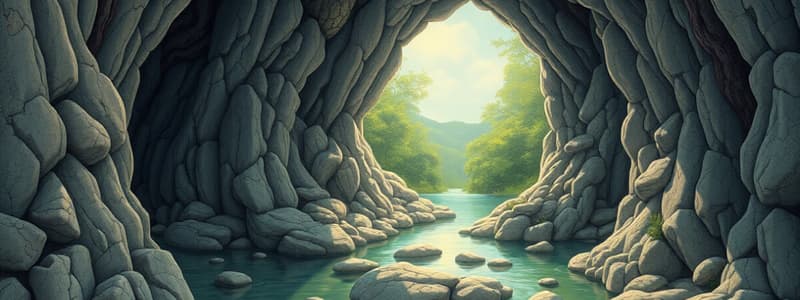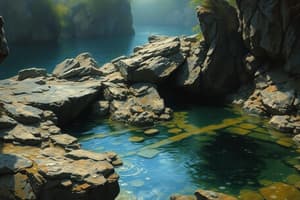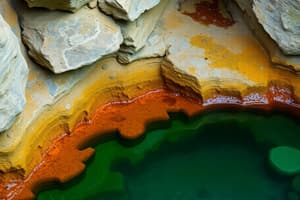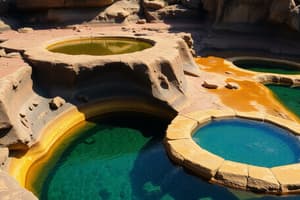Podcast
Questions and Answers
Explain why rainwater collected in tanks may not be safe for drinking, even though it's initially clean when it falls from the sky.
Explain why rainwater collected in tanks may not be safe for drinking, even though it's initially clean when it falls from the sky.
Rainwater can collect contaminants from roofs, gutters, and the air, such as bugs, dirt, minerals, and other debris, making it unsafe for consumption without proper filtration and treatment.
Differentiate between a rock hole and a spring as natural water sources, highlighting their formation and key characteristics.
Differentiate between a rock hole and a spring as natural water sources, highlighting their formation and key characteristics.
A rock hole is a surface water feature where water collects in a rocky depression, often significant in arid regions. A spring is where groundwater naturally emerges onto the surface from an underground aquifer, typically clear due to natural filtration.
Describe how rivers contribute to shaping the Earth's surface, and name two specific landforms that result from river activity.
Describe how rivers contribute to shaping the Earth's surface, and name two specific landforms that result from river activity.
Rivers erode and transport sediment, carving out valleys and canyons over time. Two landforms created by river activity are floodplains and deltas.
Explain the concept of a 'confluence' in the context of a river's upper course, and why are confluences significant in the formation of a river?
Explain the concept of a 'confluence' in the context of a river's upper course, and why are confluences significant in the formation of a river?
Relate the importance of rivers to early human settlements.
Relate the importance of rivers to early human settlements.
Flashcards
Surface Water
Surface Water
Water found on the Earth's surface that may contain contaminants like bugs, dirt, chemicals and minerals.
Rainwater Tank
Rainwater Tank
A tank used to collect rainwater, which may not be safe to drink without treatment.
Spring
Spring
A water source where water naturally flows to the surface from an underground aquifer.
River
River
Signup and view all the flashcards
Upper Course
Upper Course
Signup and view all the flashcards
Study Notes
- Surface water is not safe for drinking.
- Surface water can contain bugs, dirt, rocks, minerals, and chemicals.
- Animals may drink from and bathe in surface water, potentially adding animal droppings.
- Surface water has not been cleaned and filtered.
- Rainwater tanks collect and conserve water.
- Water from rainwater tanks may contain bugs, dirt, and minerals.
- Roof debris and gutter contents can contaminate rainwater tanks.
- Rainwater tank water is suitable for watering gardens and washing cars/clothes.
- Clean gutters of leaves and animal droppings before drinking rainwater.
- Waterholes, rock holes, and springs combine groundwater and surface water.
Rock Holes
- Rock holes are surface water features holding water in rocky areas.
- They are a crucial water source for Aboriginal people in arid Australia.
- Rock holes supply water in dry landscapes with little permanent surface water.
- They assist in traveling and accessing a larger range of resources.
Springs
- Springs occur when water from an underground aquifer surfaces naturally.
- The amount of water from springs depends on aquifer water pressure, rainfall, and human usage.
- Spring water is typically clear but can be discolored by naturally occurring minerals.
Rivers
- A river is a large natural stream of water that flows over land.
- Rivers may hold a tiny fraction of Earth's total water, but are essential to human civilization.
- Rivers carry freshwater to people, plants, and animals across Earth.
- Rivers provide transportation and water power.
- Rivers shape the land by carving out valleys and canyons.
- Rivers contain an upper course, middle course and lower course.
Upper River Course
- Rain falls in highland areas and collects in channels (streams).
- Streams join other streams, increasing in size and speed.
- A confluence is where two rivers join.
- Creeks eventually grow into rivers.
- In the upper course, rivers flow rapidly.
- Rivers cut through land, picking up soil and gravel.
- Moving water erodes rock and soil.
- Over long periods, the river creates canyons and deep valleys.
Middle River Course
- In the middle course, fast-flowing water causes erosion.
- The river erodes left and right, forming horse-shoe-like loops called meanders.
- In its middle course the river flows down gentler slopes.
- The river becomes larger and slower.
- Soil, gravel, and sand begin to sink and form sandbars and islands.
Lower River Course
- Rivers in the lower course are in flatland and flow slowly.
- The water force is lower here than in the other stages.
- Rivers deposit all the bits of eroded land it has been carrying with it.
- Rivers drop solid material and some material is carried to the mouth.
- Rivers drop material and that becomes land that is called a delta.
Erosion and Deposition
- Rivers do not travel in straight lines.
- They avoid obstacles downhill.
- People have altered river courses.
- Erosion and deposition can change the shape of a river.
- Erosion is when materials are moved by wind or water and are called sediments.
- Deposition is when sediments are deposited in a different location.
- These processes change the surface of Earth.
- Rivers demonstrate deposition by dropping materials from erosion in new locations.
- Moving waters pick up and carry sand, dirt and sediments downstream.
- Rivers often turn brown or murky.
- Rivers deposit sediments into lakes or oceans.
- The color of the water changes due to soil, rocks, and materials being deposited.
Meanders
- As meanders grow, water sometimes erodes the riverbanks causing them to merge.
- Water will take the new, shorter route.
- Over time, deposition blocks off the old part of the river.
- An oxbow lake will form due to deposition blocking the old river route.
Studying That Suits You
Use AI to generate personalized quizzes and flashcards to suit your learning preferences.




